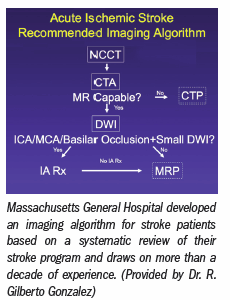Despite MR recommendation, facilities will continue CT use
The American Academy of Neurology’s new guidelines on using MRI for stroke may represent best practice, but practical issues remain, interviews with several experts revealed.
The American Academy of Neurology’s new guidelines on using MRI for stroke may represent best practice, but practical issues remain, interviews with several experts revealed.
In the July 13 issue of Neurology, the academy compared all the scientific data through 2008 on diffusion- weighted and perfusion-weighted imaging in acute ischemic stroke. A panel of experts in vascular neurology and radiology found DWI is established as useful and should be considered instead of noncontrast CT for the diagnosis of acute ischemic stroke within 12 hours of symptom onset.
“The routine practice in many hospital emergency departments is still to get a noncontrast CT to rule out stroke for all patients who present with a suspicion of acute ischemic stroke,” said Dr. Steven Warach, coauthor of the recommendations and section chief of stroke diagnostics and therapeutics at the National Institute of Neurological Disorders and Stroke. “Based on the scientific evidence, that routine practice is not justifiable and cannot be considered the highest quality of care.” No one argues MRI isn’t superior diagnostically to CT, but in the stroke world there’s a saying, “Time saved is brain saved.”
If intravenous thrombolysis is being considered, every minute is critical, said Dr. Greg Sorensen, a professor of radiology and of health sciences and technology at Harvard and a stroke expert. “Slowing down IV tissue plasminogen activator for even three minutes means that, on average, about 6 million neurons will be lost,” he said.
To save time, many facilities use CT to rule out hemorrhage so the patient can receive IV tPA as soon as possible.

“With CT, I’m looking at the CT scan while it’s being done,” said Dr. Kerri Rimmel, director of the stroke center at the University of Louisville Health Center in Kentucky. “It takes five minutes and I’ve got not only the brain scan but the vessels.”
At the same time, Rimmel agrees with the academy’s recommendations because a CT scan can be read as negative or normal in the first six or eight hours and a patient might be sent home even though he or she is experiencing symptoms of a stroke.
MR is far superior to CT in imaging the brain for stroke because it shows ischemia immediately and is very sensitive for microbleeds, she said.
“In the first 12 hours it absolutely is far superior, but I believe that we will continue to use CT in the first three hours to rule out blood,” she said. “We may add MRI after the tPA is in to further evaluate that patient.”
A recommendation like this doesn’t take into account the extra cost of staffing for MR coverage 24/7 or the practicalities of treating a patient, said Dr. M.J. Bernadette Stallmeyer, an interventional neuroradiologist at Our Lady of Lourdes Regional Medical Center in Lafayette, LA, and a member of the Society of Interventional Radiology’s Catheter Lysis of Thromboembolic Stroke course steering committee.
“I was at a big academic center before Our Lady of Lourdes and, all things being equal, if the patient was in the ER, it was a lot easier to send them 30 feet down the hall for a CT scan than it was to send them to the next building for an MR,” she said.
MRI may not be widely available, and some people say it is impractical, but that doesn’t change MRI’s superior performance, Sorensen said.
“Just as we seek to make CPR more widely available for heart attack victims, it makes sense to work to make MRI more available for stroke victims,” he said.
MRI as first-line imaging for stroke patients is practiced at Helsinki University Central Hospital in Helsinki, Finland, and at La Timone University Hospital in Marseille, France, with very rapid door-to-needle times, according to Sorensen. Instead of staffing a CT 24 hours a day, these sites have chosen to prioritize MRI.
“Those who claim MRI is impractical are not informed-or the right systems are not yet in place to make it practical-but these systems can be put in place,” he said.
If a hospital doesn’t have an MRI machine, or the patient has a contraindication, there is no choice but to use CT, Warach said. If those aren’t at issue, though, it’s hard to defend not using MR for stroke based on the scientific data.
New Analysis Forecasts Substantial Cost Savings with the Use of Photon Counting CT for CCTA
March 8th 2025The use of ultra-high-resolution photon-counting CT in the evaluation of stable chest pain may significantly reduce follow-up tests and invasive coronary angiography (ICA) procedures, possibly resulting in millions in health-care cost savings, according to a cost-effectiveness analysis presented recently at the European Congress of Radiology.
The Reading Room: Racial and Ethnic Minorities, Cancer Screenings, and COVID-19
November 3rd 2020In this podcast episode, Dr. Shalom Kalnicki, from Montefiore and Albert Einstein College of Medicine, discusses the disparities minority patients face with cancer screenings and what can be done to increase access during the pandemic.